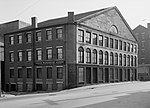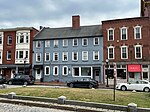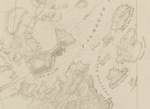Middle Street

Middle Street is a downtown street in Portland, Maine, United States. Dating to 1724 (although part of it was a path established by ancient settlers), it runs for around 0.46 miles (0.74 km), from an intersection with Union Street, Spring Street and Temple Street in the southwest, to Hancock Street, at the foot of Munjoy Hill, in the northeast. It formerly originated at what was then known as Market Square (today's Monument Square), but 20th-century redevelopment saw the section between Monument Square and Free Street pedestrianized, and the remaining section—around The Maine Lobsterman monument on Temple Street—erased. Near its midsection, Middle Street crosses Franklin Street. In 1756, when Franklin Street was laid out between Middle Street and Back Street (today's Congress Street), it was known as Fiddle Street. In the early 1950s, the newly created Slum Clearance and Redevelopment Authority Vine-Deer-Chatham project demolished Portland's Little Italy, which was bounded by Franklin Street to the east, Fore Street to the south, Pearl Street to the west and Middle Street to the north. The head of Deer Street was opposite the Thompson Block at 117–125 Middle Street. Middle Street, which is named for its position between Congress Street and Fore Street, passes through Portland's Old Port district.
Excerpt from the Wikipedia article Middle Street (License: CC BY-SA 3.0, Authors, Images).Middle Street
Exchange Street, Portland
Geographical coordinates (GPS) Address Nearby Places Show on map
Geographical coordinates (GPS)
| Latitude | Longitude |
|---|---|
| N 43.65649837 ° | E -70.25332479 ° |
Address
Exchange Street 1
04101 Portland
Maine, United States
Open on Google Maps










